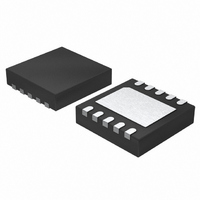MCP73838T-FCI/MF Microchip Technology, MCP73838T-FCI/MF Datasheet - Page 21

MCP73838T-FCI/MF
Manufacturer Part Number
MCP73838T-FCI/MF
Description
IC LIION CHRGR USB/AC-IN 10DFN
Manufacturer
Microchip Technology
Datasheet
1.MCP73838T-FJIMF.pdf
(30 pages)
Specifications of MCP73838T-FCI/MF
Battery Type
Lithium-Ion (Li-Ion), Lithium-Polymer (Li-Pol)
Function
Charge Management
Voltage - Supply
4.5 V ~ 6 V
Operating Temperature
-40°C ~ 85°C
Mounting Type
Surface Mount
Package / Case
10-DFN
Input Voltage
6V
Battery Charge Voltage
4.5V
Charge Current Max
1A
Battery Ic Case Style
DFN
No. Of Pins
10
No. Of Series Cells
1
Product
Charge Management
Output Voltage
4.2 V, 4.35 V, 4.4 V, 4.5 V
Output Current
1200 mA
Operating Supply Voltage
3.75 V to 6 V
Maximum Operating Temperature
+ 85 C
Minimum Operating Temperature
- 40 C
Mounting Style
SMD/SMT
Lead Free Status / RoHS Status
Lead free / RoHS Compliant
Lead Free Status / RoHS Status
Lead free / RoHS Compliant, Lead free / RoHS Compliant
Other names
MCP73838T-FCI/MFTR
Available stocks
Company
Part Number
Manufacturer
Quantity
Price
Company:
Part Number:
MCP73838T-FCI/MF
Manufacturer:
Microchip Technology
Quantity:
1 943
EQUATION 6-1:
For example, power dissipation with a 5V, ±10% input
voltage source and 500 mA, ±10% fast charge current
is:
EXAMPLE 6-1:
This power dissipation with the battery charger in the
MSOP-10 package will cause thermal regulation to be
entered as depicted in
3 mm x 3 mm DFN package could be utilized to reduce
the charge cycle times.
6.1.1.3
The MCP73837/8 is stable with or without a battery
load. In order to maintain good AC stability in the
Constant Voltage mode, a minimum capacitance of
1 µF is recommended to bypass the V
This capacitance provides compensation when there is
no battery load. In addition, the battery and
interconnections appear inductive at high frequencies.
These elements are in the control feedback loop during
Constant Voltage mode. Therefore, the bypass
capacitance may be necessary to compensate for the
inductive nature of the battery pack.
Virtually any good quality output filter capacitor can be
used, independent of the capacitor’s minimum
Effective Series Resistance (ESR) value. The actual
value of the capacitor (and its associated ESR)
depends on the output load current. A 1 µF ceramic,
tantalum, or aluminum electrolytic capacitor at the
output is usually sufficient to ensure stability for output
currents up to 500 mA.
6.1.1.4
The MCP73837/8 provides protection from a faulted or
shorted input. Without the protection, a faulted or
shorted input would discharge the battery pack through
the body diode of the internal pass transistor.
6.1.1.5
The current regulation set input pin (PROG1/2) can be
used to terminate a charge at any time during the
charge cycle, as well as to initiate a charge cycle or
initiate a recharge cycle.
© 2007 Microchip Technology Inc.
Where:
PowerDissipation
I
V
PowerDissipation
V
REGMAX
PTHMIN
DDMAX
External Capacitors
Reverse-Blocking Protection
Charge Inhibit
= the maximum input voltage
= the maximum fast charge current
= the minimum transition threshold
voltage
=
=
(
V
DDMAX
(
5.5V 2.7V
Figure
–
–
V
6-3. Alternatively, the
PTHMIN
)
×
550
BAT
)
mA
×
I
REGMAX
pin to V
=
1.54W
SS
.
Placing a programming resistor from the PROG1 input
to V
the device. Allowing either the PROG1 or PROG2 input
float disables the device and terminates a charge cycle.
When disabled, the device’s supply current is reduced
to 75 µA, typically.
6.1.1.6
The charge temperature window can be set by placing
fixed value resistors in series-parallel with a thermistor.
The resistance values of R
with the following equations in order to set the
temperature window of interest.
For NTC thermistors:
EQUATION 6-2:
For example, by utilizing a 10 kΩ at 25°C NTC
thermistor with a sensitivity index, β, of 3892, the
charge temperature range can be set to 0°C - 50°C by
placing a 1.54 kΩ resistor in series (R
69.8 kΩ resistor in parallel (R
6.1.1.7
A status output provides information on the state of
charge. The output can be used to illuminate external
LEDs or interface to a host microcontroller. Refer to
Figure 5-1
output during a charge cycle.
6.2
For optimum voltage regulation, place the battery pack
as close as possible to the device’s V
recommended to minimize voltage drops along the
high current-carrying PCB traces.
If the PCB layout is used as a heatsink, adding many
vias in the heatsink pad can help conduct more heat to
the backplane of the PCB, thus reducing the maximum
junction temperature.
Where:
R
SS
R
COLD
HOT
R
R
or driving PROG2 to logic High or Low enables
T1
T2
PCB Layout Issues
for a summary of the state of the status
Temperature Monitoring
Charge Status Interface
=
=
=
24k
5k
Ω
Ω
the fixed series resistance
the fixed parallel resistance
the thermistor resistance at the
lower temperature of interest
the thermistor resistance at the
upper temperature of interest
=
=
MCP73837/8
R
R
T1
T1
T1
+
+
and R
R
---------------------------- -
R
T2
R
-------------------------------- -
R
T2
T2
T2
T2
) with the thermistor.
×
+
×
+
T2
R
R
R
R
HOT
HOT
DS22071A-page 21
COLD
COLD
BAT
can be calculated
and V
T1
), and a
SS
pins,














